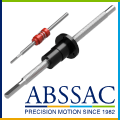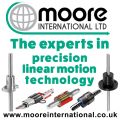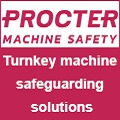
Posted to News on 14th Jul 2008, 21:42
Automated cell trims mouldings with six-axis robot and laser
ATM has built an automated cell for trimming flash from blow mouldings, with the cell benefiting from a six-axis robot and a laser that operates 'out of focus' to overcome the challenge of part-to-part dimensional variations.

ATM has been involved in many diverse and challenging automation projects in the plastics industry. However, when Polypipe asked ATM to devise an automated system for removing flash from its range of blow-moulded Ridgigully products, ATM was presented with a highly unusual combination of design, process and health and safety challenges.
Polypipe Civils is described as the UK's leading manufacturer of surface water drainage, sewerage, cable protection systems and water management products, serving the utilities, construction, civil engineering, agricultural and sports and leisure markets. As part of the Polypipe surface water drainage system, Ridgigully products are blow-moulded in HDPE (high-density polyethylene) in three sizes. The post-moulded products incorporate significant amounts of flash around the mould joint line that has traditionally been removed manually. The largest of these parts weighs up to 12kg and, with some areas of flash being up to 12mm thick, removing this manually was both time-consuming and arduous.
Following a review of various flash removal processes and automation concepts by Polypipe, ATM was chosen to provide a fully automated flash removal system based on a six-axis robot and a laser. The combination of a laser with a six-axis robot is not in itself new, and ATM already had previous experience of building systems of this type for automotive industry customers. Automotive laser cutting applications, by their very nature, are fine-tolerance processes and, while this demands precise programming and control over the robot path, the fact that the components have clearly defined datum points means that the laser and robot together can easily meet the dimensional and profile tolerances required. There are, however, a number of distinct differences between these automotive projects and the Polypipe application, not least the larger tolerance band of the blow-moulded part and the material from which the part is produced.
Project objectives
From the outset, this was clearly going to be a demanding application and ATM was determined to ensure that the system specification reflected the nature of the project. With three different sizes of product to be laser cut (300, 750 and 900mm) and a requirement to not only remove flash from the moulding but also to cut two 360 degree paths, ATM determined that the optimum system would have the robot holding the part and manipulating it under a fixed laser cutting head. A six-axis robot with a horizontal reach of 2000 mm and a payload capacity of 50kg was chosen to provide the working range and handling capacity required for these large components.
ATM chose Rofin-Baasel UK as the supplier of the laser system, based upon its extensive application experience and the excellent reputation for reliability of Rofin CO2 lasers. A diffusion-cooled slab laser with an output power of 2500W was selected for the project. Detailed consideration also had to be given to fume extraction and filtration for this project, as the parts being cut are produced from 100 per cent regrind material. This means that the blow mouldings can contain a number of contaminants, which could have a detrimental impact on the performance of any extraction and filtration system. Following a series of trials, a multi-stage dosing filter system was developed, with the air extracted from the cell being dosed with calcium carbonate before reaching the filtration system. To minimise the time associated with cleaning filters and removing debris from the filtration system, two sets of filters were incorporated. This enables one set of filters to perform a self-cleaning cycle, depositing any dust and debris in a bin, while the system continues to run using the second set of filters.
The workcell concept incorporates two component fixtures at the operator load and unload station. This enables the robot to deposit a completed part and immediately pick up a new part, thereby ensuring minimum time is lost between the laser cutting operations. With an internal safety door closed to protect the operator, the finished part can be manually removed and another part loaded for processing by the robot. The robot gripper system and the component location fixtures incorporate quick-change tooling features to enable the system to handle the three product sizes.
The challenges of this project were not just limited to selecting the most appropriate hardware.
Material utilisation
The Ridgigully components required flash to be removed from all areas around the mould tool joint line and, in places, this flash can be up to 12mm thick. In addition, to enable the flash being removed to be re-processed more easily, the larger areas of waste material had to be cut into smaller pieces. This required intricate programming by the ATM engineers to achieve the balance between reducing the size of the waste material and maintaining the target cycle time.
The major issue yet to be overcome in this application was the need to produce trimmed components with a minimum of excess material, on components that have potentially large part-to-part variations in size. The variation on each component meant that it was not possible to establish a consistent datum position, from which programme offsets could be generated, and this led the ATM engineers to develop a highly unusual but extremely effective alternative.
In almost every laser application, the beam is focussed to a fine spot, at a particular distance from the nozzle or optics, to generate a small spot size and enable precision processing of the part. Even with a powerful laser such as the Rofin DC025 a spot size of 1.0mm is achievable at the appropriate focal distance. This application, however, did not require such degrees of accuracy due to the variations in part tolerance, and ATM turned this to its advantage. By developing clever programming techniques and using the laser out of focus, a larger spot size was achieved. Using the laser outside of its focal point would require more laser power to cut the material, and ATM's initial choice of a 2500W laser proved to be a major contributing factor in the project's success. The larger spot size, together with the higher power settings on the laser, enabled the system to not only achieve the cut profiles required during flash removal, but the high temperatures reached during the trimming operation also partially melt the cut area, providing a smooth and aesthetic finish on the part.
Polypipe has achieved its objectives of turning a labour-intensive and arduous task into a cost-effective and highly reliable automated process. ATM has also clearly demonstrated that difficult and unusual automation applications can become a reality using a combination of field-proven hardware, lateral thinking, and a determination to satisfy the customer's requirements.
Unit F, Blaby Industrial Park
Winchester Avenue
LE8 4GZ
UNITED KINGDOM
44 116 277 3607

































